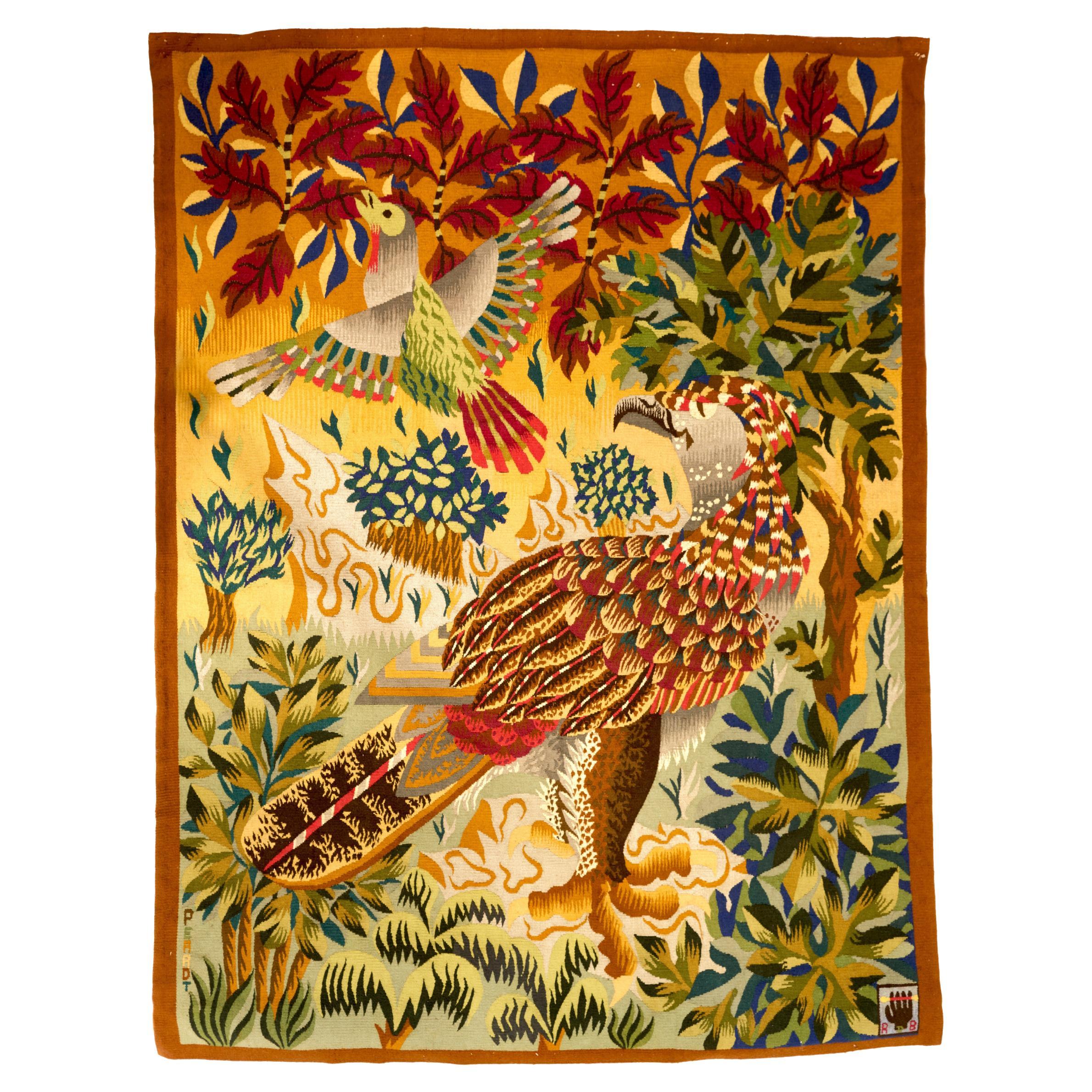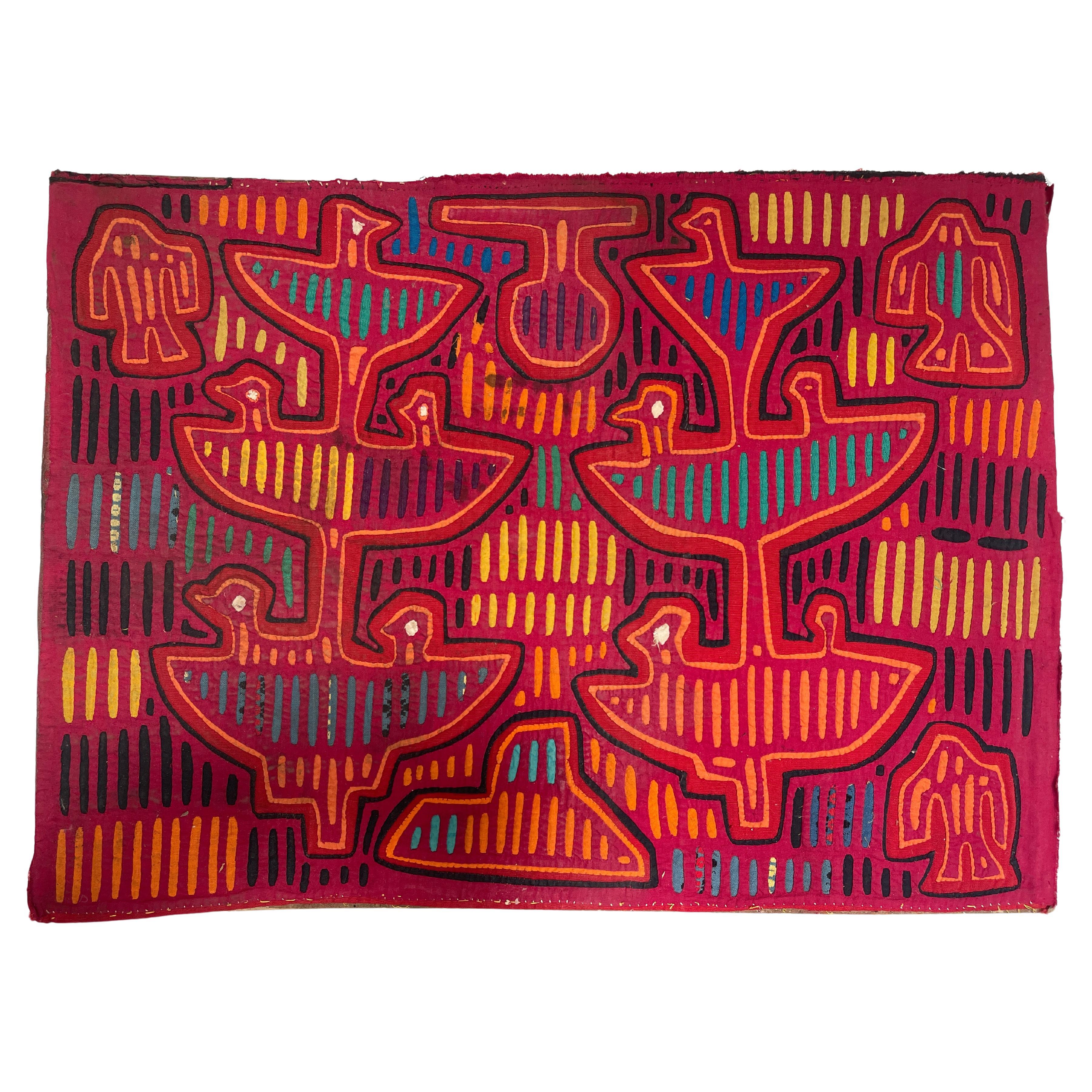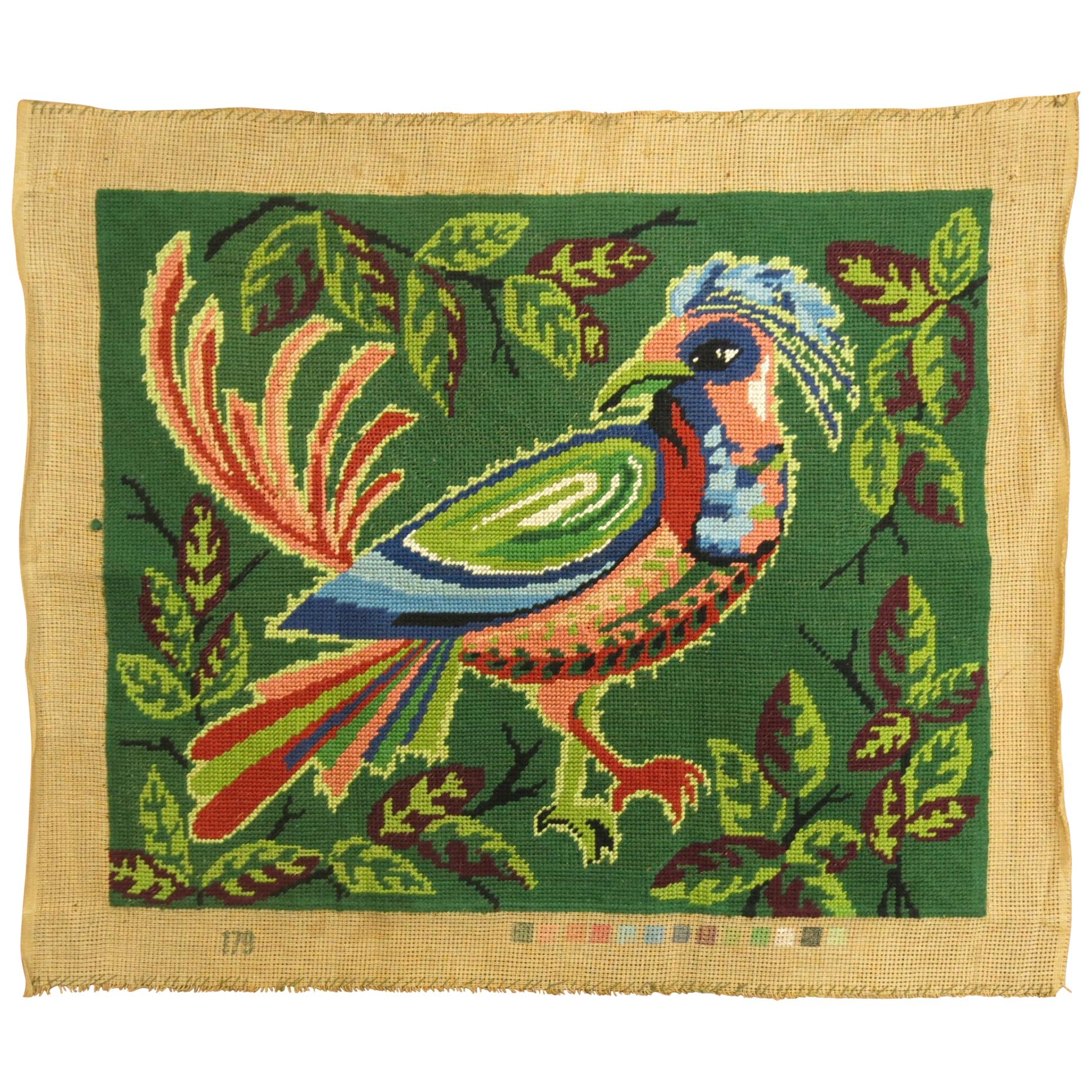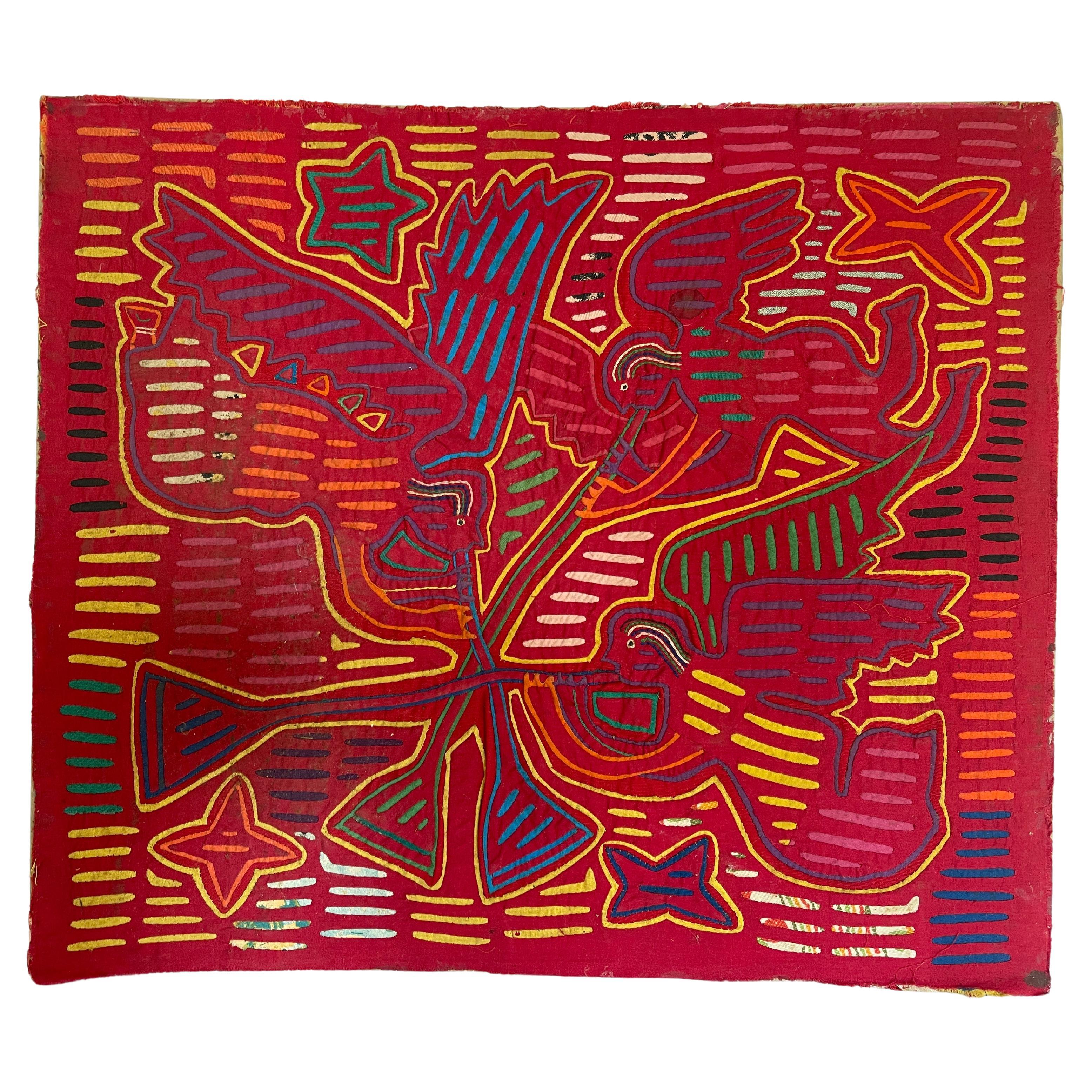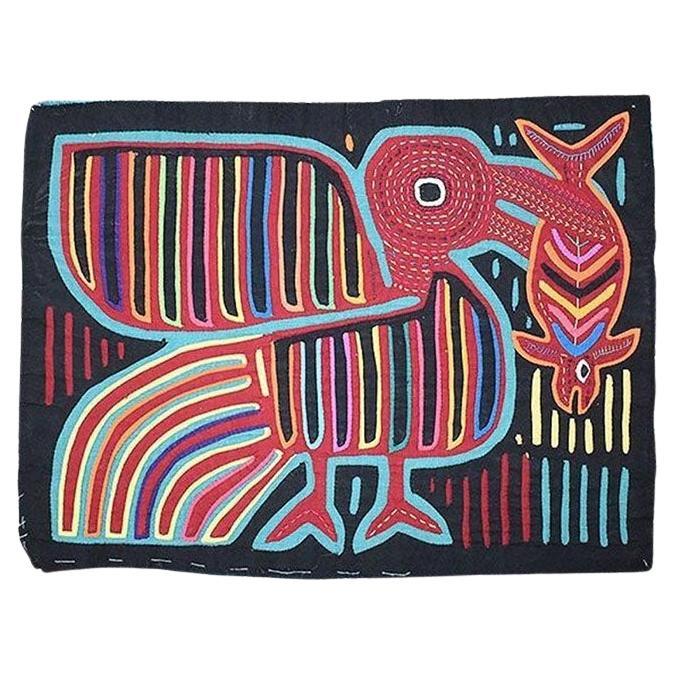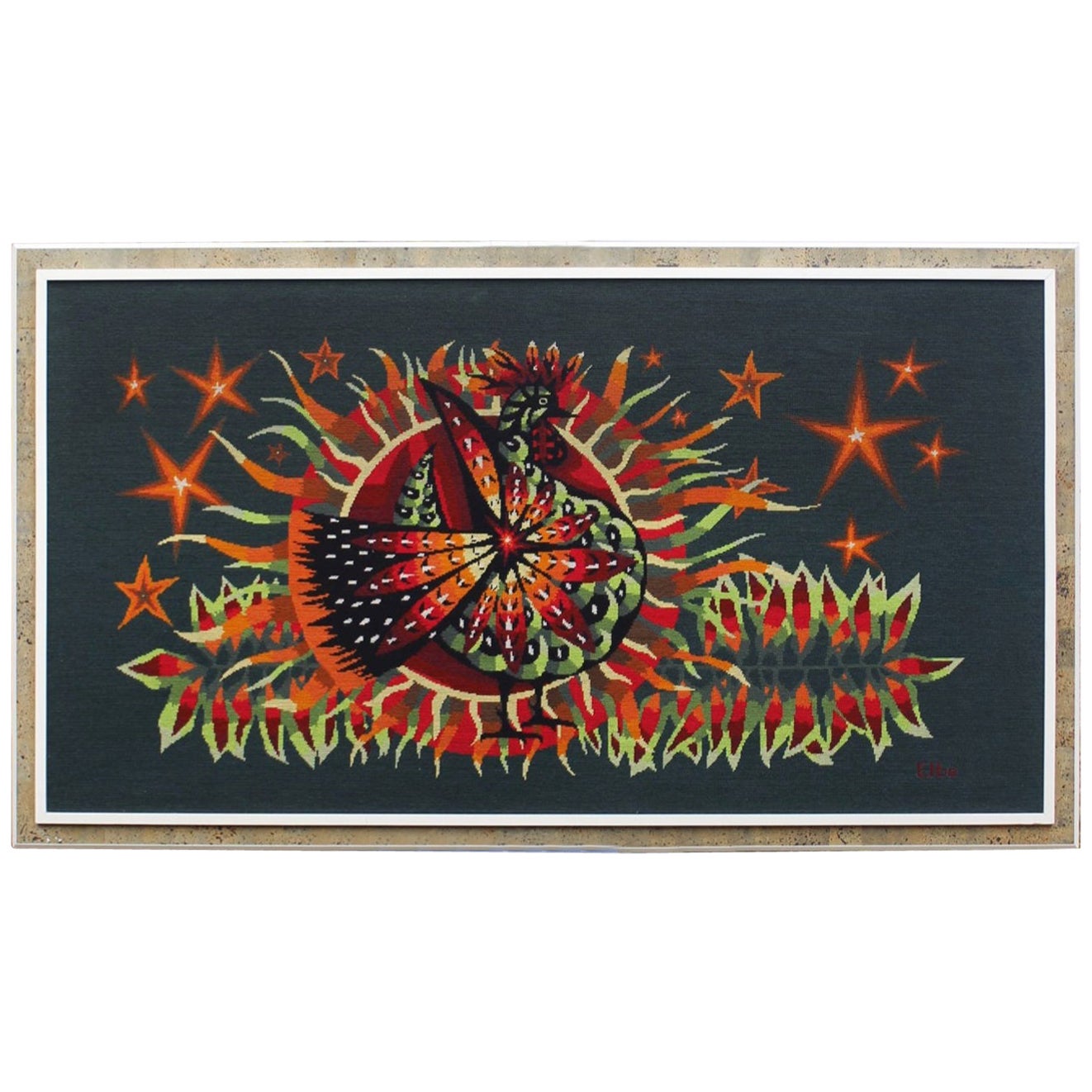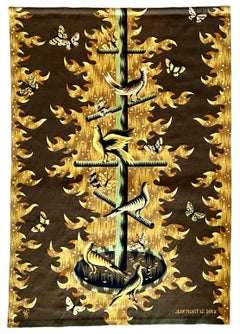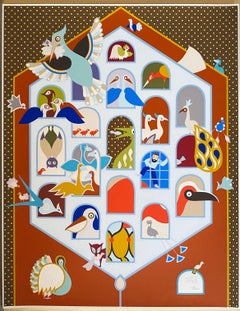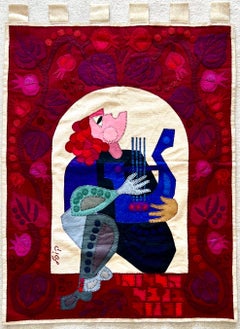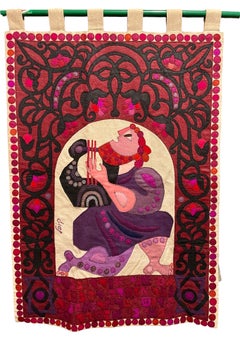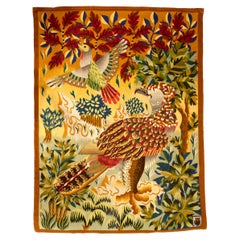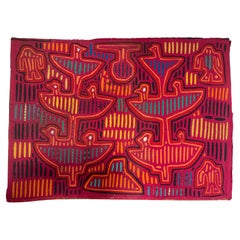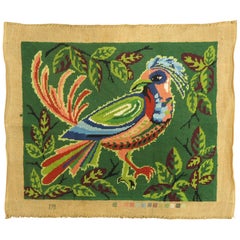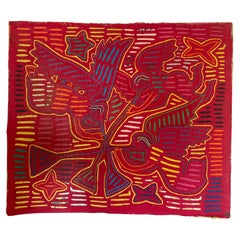Items Similar to Israeli Bird and Fish Hand Woven Itche Mambush Atelier Aubusson Style Tapestry
Want more images or videos?
Request additional images or videos from the seller
1 of 5
Sami BrissIsraeli Bird and Fish Hand Woven Itche Mambush Atelier Aubusson Style Tapestry
$6,000
£4,524.60
€5,232.91
CA$8,417.97
A$9,357.09
CHF 4,904.79
MX$114,272.76
NOK 61,233.45
SEK 57,609.26
DKK 39,056.93
About the Item
This is an Aubusson style flat weave hand woven wool tapestry. This is from the Itche Mambush workshop. it is edition 2/5 (He worked with Mordechai Ardon, Marcel Janco, Abraham Rattner and others inspired By Jean Lurcat and Jean Picard le Doux)
Sami Briss (French/Roumanian/Israeli) Born May 18, 1930,
Jassy, Roumania (Jassy, Romania). Immigrated to Israel in 1960. Created
monumental works for the Weizmann Institute of Science in Rehovot, and for
Hadassah Hospital in Jerusalem. Since 1973 lives in Paris, France. His
works are in museum and private collections in Romania, West Germany,
France, Sweden, Holland, Luxembourg, Canada, U.S.A., etc. Sammi was born on
the 18th of May, 1930 in Jassey, Roumania. With the onset
of the Second World War, the family fled to Bucharest where Briss enrolled
at the "BeauxArts" Academy. Here he worked under Camil Ressu, a former
student of Gustave Moreau. After leaving the Academy, Briss, active mainly
as a printmaker, produced wooden sculptures and lithographs which were
widely published. These were, like his earlier still life paintings
reminiscent of the constructivism of George Braque and Cezanne. His
interpretation of nature and its beings also had a certain relationship to
the surrealism of his compatriot, Victor Brauner and the imagery of Paul Klee and André
Breton. However, Briss' work cannot be connected with any precise aesthetic
code as that of his contemporaries.
In 1959 Briss emigrated to Israel where he held his first Retrospective in
1967 at the Nathan Gallery in Tel Aviv. He is part of a generation of post war Israeli artists which include Yaacov Agam, Samuel Bak, Yosl Bergner, Naftali Bezem, Shmuel Katz, David Sharir, Calman Shemi, Jacob Steinhardt, Yossi Stern and Shraga Weil. Here Briss also painted several
murals in public buildings during the first half of the 70`s. It is at the beginning of the 60`s that he began painting in oil and watercolours in the "petits format" which he extended by creating Baroque montages, or works in glass frames decorated with velvet fabric or precious wood in the manner reminiscent of the religious icons so widespread in Russia, Bulgaria, and the churches of his native land.
Select solo shows: Galerie Romanet, Paris Galerie Art Actuel, Nancy Galerie Bellido, Den Haag Galerie F. Kohn Galerie le Hiboux, Luxembourg Galerie
Elca London, Montreal Safrai Gallery, Tel Aviv
Galerie Hoffman, Koln Galerie Amillis, Bruxelles Galerie du Forum, Reims Galerie Meissner, Hamburg Galerie Kishi, Osaka, Japan Noortman, Maastricht, Holland Hadassa K. Gallery, Tel Aviv Galerie St. Gilles, Liege Galerie Zur Krone, Switzerland Galerie D'Etraz, Lausanne Galerie Den
Bieman de Haas, Amsterdam Galerie D'Etraz, Lausanne Group exhibitions: Art Basel, Artexpo
New York, Artexpo Los Angeles,
This is an Aubusson Gobelin style wool tapisserie similar to Pinton, Tabard, Robert Four and other masterpiece workshops. these take months to make.
Sammy Briss art, which is connected to no precise
code of contemporary art, he calls upon varied legends to create his own
vocabulary of symbols.The fish appears in his works as the symbol of abundance, hands evoke
strength and happiness, and birds in flight emphasize a hope of detachment.
Based in his two kingdoms of Paris and Tel Aviv, the land of Israel is
evoked in Briss' paintings by the ruins of the temples. Briss' art depicts
a series of figures, some perturbed, some serene, while his paintings are
just as much dynamic as calm, complex and precise.
- Creator:Sami Briss (1930, French)
- Dimensions:Height: 56 in (142.24 cm)Width: 42 in (106.68 cm)
- Medium:
- Movement & Style:
- Period:
- Condition:
- Gallery Location:Surfside, FL
- Reference Number:1stDibs: LU38210731892
About the Seller
4.9
Platinum Seller
Premium sellers with a 4.7+ rating and 24-hour response times
Established in 1995
1stDibs seller since 2014
1,799 sales on 1stDibs
Typical response time: <1 hour
- ShippingRetrieving quote...Shipping from: Surfside, FL
- Return Policy
Authenticity Guarantee
In the unlikely event there’s an issue with an item’s authenticity, contact us within 1 year for a full refund. DetailsMoney-Back Guarantee
If your item is not as described, is damaged in transit, or does not arrive, contact us within 7 days for a full refund. Details24-Hour Cancellation
You have a 24-hour grace period in which to reconsider your purchase, with no questions asked.Vetted Professional Sellers
Our world-class sellers must adhere to strict standards for service and quality, maintaining the integrity of our listings.Price-Match Guarantee
If you find that a seller listed the same item for a lower price elsewhere, we’ll match it.Trusted Global Delivery
Our best-in-class carrier network provides specialized shipping options worldwide, including custom delivery.More From This Seller
View AllArt Deco French Modernist Handmade Aubusson Gobelin Tapestry Jean Picart Le Doux
By Jean Picart Le Doux
Located in Surfside, FL
Jean Picart Le Doux, French (1902 - 1982)
"Au Rendez Vous Des Oiseaux"
Larger handmade wool Aubusson tapisserie
Produced by Maison M. Berthaut Aubusson Atelier, France. Signed Lower left corner woven with firm's monogram and lower right with artists full name.
Bears stitched label attached en verso.
Original documents included with the lot.
Measures 71-1/2" x 50".
Jean Picart Le Doux, born in Paris in 1902 and died in 1982, was a French painter and painter-cartonnier the revival of contemporary flat weave tapestry. He is the son of the painter Charles Picart Le Doux (1881-1959). His first tapestry dating from 1943 after winning the Grand Prix of the theater poster exhibition in the imaging. He met Jean Lurcat and, and Marc Saint-Saëns,and together they founded the Association of painters cardboard tapestry in 1947. In 1950, he comes up with the idea for the Alliance Graphique Internationale, during the meeting with exhibitors of an exhibition of their work in Basel, Switzerland along with two other French designers Jean Jacques Colin and Nathan, and two Swiss graphic designers, Fritz Buhler and Donald Brown. AGI is officially founded November 22, 1952 and Picart Le Doux will be its first president.
Picart Le Doux was a French artist noted for his role in the revival of contemporary hand woven Aubusson tapestry. Picart Le Doux's first tapestry cartoon was a diptych entitled The Four Seasons. Made in 1943...
Category
Mid-20th Century Modern More Art
Materials
Wool
Israeli Naive Folk Art Birdhouse Silkscreen Lithograph David Sharir Birds
By David Sharir
Located in Surfside, FL
David Sharir was born in 1938 in Tel Aviv, Israel and currently resides there.
David Sharir, the son of Russian immigrants, was born in Israel. Beginning his study of art in Tel Aviv...
Category
20th Century Folk Art Figurative Prints
Materials
Screen
Wool Felt Applique Israeli Folk Art Signed Tapestry Kopel Gurwin Bezalel School
By Kopel Gurwin
Located in Surfside, FL
This depicts KIng David reciting Psalms, Hallelujah in Hebrew
Kopel Gurwin (Hebrew: קופל גורבין) (1923–1990) was an Israeli tapestry wall hanging, painter and graphic artist.
Kopel (Kopke') Gurwin (Gurwitz) was born and raised in Vilna, the capital of Lithuania. He spoke Yiddish at home, but simultaneously studied Hebrew at their school which was part of the Tarbut educational network. Kopel was active in the Hashomer Hatzair youth movement. In the 1930s, as a teenager, Kopel helped his parents with the home finances by working in a suit workshop, there he first encountered the art of sewing.
With the outbreak of the Second World War and the German invasion of Vilna, the Jews were imprisoned in camps and ghettos. Kopel and his brother Moshe were separated from their parents and were put to work in coal mines and peat. Kopel's parents were taken to the Stutthof Nazi concentration camp where they died of typhus within a month of each other. Kopel's 12-year-old sister Chava was turned over to the Germans by a Polish family and murdered.
The brothers were arrested by the Germans, but were saved thanks to the connections of Nina Gerstein, Kopel's drama teacher. They hid in an attic until they were discovered, fled and moved to Riga, where they were caught and sent to the Stutthof concentration camp where they were imprisoned until the end of the war. They were put to work maintaining and cleaning trains and took part in one of the death marches. In July 1946, Kopel and Moshe sailed to Helsingborg, Sweden, as part of operation "Folke Bernadotte", in which Sweden took in ill survivors for rehabilitation. Once he recovered, Kopel worked in a publishing house and later was appointed director of the local branch of the Halutz movement.
In 1950 Kopel and Moshe made aliyah to Israel. Kopel worked as a survey for the Survey of Israel Company. In 1951, he enlisted to the Communication Corps and served as a military draftsman. There he won first prize for the design of the front cover of the Communication Corps bulletin.
With his discharge from the army at 29 he started studying drawing and graphics at the Bezalel Academy of Arts and Design in Jerusalem. Among his teachers were Isidor Ascheim, Shlomo Vitkin, Yossi Stern and Jacob Steinhardt. At the end of his first year of study, Kopel won the Reuben and Sarah Lif Excellence Award in written studies. During his studies he also won additional prizes: In 1956 he won first prize from the Lethem Foundation in California for poster design. Later the same year, Kopel won the Hermann Struck prize for his drawing on the theme of Jerusalem.
In 1957 he won an additional first prize from the Lethem Foundation and second place from the printing company Ortzel for a drawing for a Jewish New Year greeting card. In 1958 he won first prize in a competition to design a poster for Tel Aviv's jubilee.
Two years later he won three other awards: First and third prize for designing a poster for Israel Independence Day, celebrating 12 years of the State of Israel.
Also that year Kopel won first prize for a poster to mark the 25th Zionist Congress.
In 1964 he entered the Independence Day poster competition on the theme of aliyah and won first and second prize. Four years later he again entered the competition on the theme of 20 years of Israel's independence and won first prize. The poster was styled like a Holy Ark curtain with two lions and a menorah at its centre. This poster appeared on the cover of the famous book Jewish Art and Civilization, edited by Geoffrey Wigoder as well as the record Voices of 20 Years, 1948-1968, edited by Yossi Godard. In April 1971 he won first prize in the Independence Day poster competition for the fourth time.
Kopel's Folk Art tapestry won the Israeli Independence Day Poster Contest in 1968
With the completion of his studies at Bezalel Kopel moved to Tel Aviv and was hired by Shmuel Grundman's graphics and design studio. Grundman took him to Europe with him to design and supervise the construction of Israeli exhibition pavilions. During his time at Grundman's he discovered the fibrous felt from which he produced most of his wall hangings. At the 1964 Levant Fair exhibition he used felt stuck onto wooden panels for the first time.
The first felt wall hanging that Kopel produced was intended for the American Cultural Centre in Jerusalem and its theme was the United States Declaration of Independence. The wall hanging, which measured 2.85 X 1.85 meters, was stuck on a wooden panel. Kopel ordered rolls of felt from France and began work on wall hangings based on bible stories. He used a needle, hand sewing small even stitches with black embroidery thread which framed and highlighted every detail in the work, as well as using appliqué. The interior designer, Alufa Koljer-Elem, introduced him to Ruth Dayan who managed the shop Maskit in September 1967 he opened his first solo exhibition at the Maskit 6 gallery, in which 12 wall hangings were displayed.
In light of the exhibition at Maskit 6, Meira Gera, the director of artistic activity at the America-Israel Cultural Foundation, organized an additional exhibition of his works at the foundation's exhibition hall in New York City. The exhibition sparked immense press interest, and was also displayed for a few months at the New York Jewish Museum, from where it travelled throughout the United States.
Followed by the exhibition at the Delson-Richter gallery in Old Jaffa, which was later also exhibited at the Jerusalem Theatre.
Kopel's tapestry "The Time for Singing has Arrived" was printed on a UNICEF greeting card in 1978 and again in 1981.
The Israeli Philatelic Service issued three stamps based on three of Kopel's holy ark curtains and one stamp based on an Independence Day poster he designed.
Kopel's creations decorate a large number of synagogues, public buildings, hotels and private collections which were purchased in Israel and around the world. They have decorated, among others, the walls of the King David Hotel in Jerusalem, the VIP room at Ben Gurion Airport, the Kfar Saba theatre and the Plaza Hotel in Tel Aviv.
Israel has had a Vibrant Folk Art, Naive art scene for a long time now artists like Israel Paldi, Nahum Guttman, Reuven Rubin had naive periods. The most well know of the strict naive artists are Shalom of Safed, David Sharir, Irene Awret, Gabriel Cohen, Natan Heber, Michael Falk and Kopel Gurwin.
Exhibitions:
1995 The Knesset Jerusalem
1988 Temple Beth Shalom Miami, Florida
1988 University of Jewish Studies Los Angeles
1987 Israel Congregation on the Northern Coast Chicago
1985 Jerusalem Theatre Jerusalem
1984 Tenafly New Jersey
1983 Horace Richter Gallery Old Jaffa
1974 Jerusalem Theatre Jerusalem
1974 Delson Richter Gallery Old Jaffa
1972 University of Jewish Studies Miami, Florida
1971 Jewish Museum New York
1970 Norman Gallery Canada
1970 Sharei Tzedek Congregation Winnipeg, Canada
1970 Gallery of the Year Los Angeles
1970 Gallery of the Year Scottsdale
1969 Gleeman Gallery Chicago
1969 Israel Congregation of the Northern Coast Chicago
1967 Maskit 6 Tel Aviv
Prizes:
1971 First Independence Day poster 1971, 23 yeaes of the State of Israel
1969 Second International Tel Aviv poster...
Category
20th Century Folk Art Mixed Media
Materials
Wool, Felt
Wool Felt Craft Applique Vintage Israeli Judaica Folk Art Tapestry Kopel Gurwin
By Kopel Gurwin
Located in Surfside, FL
This depicts King David playing the harp, along with a verse in Hebrew from the Psalms. all made by hand. woven and stitched. Vintage, original piece.
Kopel Gurwin (Hebrew: קופל גור...
Category
20th Century Folk Art Mixed Media
Materials
Wool, Felt
Modernist Israeli Soft Tapestry Wall Hanging Rug Calman Shemi
By Calman Shemi
Located in Surfside, FL
this is a bright vibrant abstract wall hanging tapestry by Calman Shemi. I believe the material is wool with a linen backing but i am not positive. it can also be used as a floor rug...
Category
1980s Abstract Expressionist Mixed Media
Materials
Wool, Mixed Media
Wool Felt Applique Israeli Folk Art Signed Tapestry Kopel Gurwin Bezalel School
By Kopel Gurwin
Located in Surfside, FL
This depicts a Crab, In Hebrew Mazel Sartan (the Zodiac symbol Cancer, June-July) all made by hand. woven and stitched.
Kopel Gurwin (Hebrew: קופל גורבין) (1923–1990) was an Israeli tapestry wall hanging, painter and graphic artist.
Kopel (Kopke') Gurwin (Gurwitz) was born and raised in Vilna, the capital of Lithuania. He spoke Yiddish at home, but simultaneously studied Hebrew at their school which was part of the Tarbut educational network. Kopel was active in the Hashomer Hatzair youth movement. In the 1930s, as a teenager, Kopel helped his parents with the home finances by working in a suit workshop, there he first encountered the art of sewing.
With the outbreak of the Second World War and the German invasion of Vilna, the Jews were imprisoned in camps and ghettos. Kopel and his brother Moshe were separated from their parents and were put to work in coal mines and peat. Kopel's parents were taken to the Stutthof Nazi concentration camp where they died of typhus within a month of each other. Kopel's 12-year-old sister Chava was turned over to the Germans by a Polish family and murdered.
The brothers were arrested by the Germans, but were saved thanks to the connections of Nina Gerstein, Kopel's drama teacher. They hid in an attic until they were discovered, fled and moved to Riga, where they were caught and sent to the Stutthof concentration camp where they were imprisoned until the end of the war. They were put to work maintaining and cleaning trains and took part in one of the death marches. In July 1946, Kopel and Moshe sailed to Helsingborg, Sweden, as part of operation "Folke Bernadotte", in which Sweden took in ill survivors for rehabilitation. Once he recovered, Kopel worked in a publishing house and later was appointed director of the local branch of the Halutz movement.
In 1950 Kopel and Moshe made aliyah to Israel. Kopel worked as a survey for the Survey of Israel Company. In 1951, he enlisted to the Communication Corps and served as a military draftsman. There he won first prize for the design of the front cover of the Communication Corps bulletin.
With his discharge from the army at 29 he started studying drawing and graphics at the Bezalel Academy of Arts and Design in Jerusalem. Among his teachers were Isidor Ascheim, Shlomo Vitkin, Yossi Stern and Jacob Steinhardt. At the end of his first year of study, Kopel won the Reuben and Sarah Lif Excellence Award in written studies. During his studies he also won additional prizes: In 1956 he won first prize from the Lethem Foundation in California for poster design. Later the same year, Kopel won the Hermann Struck prize for his drawing on the theme of Jerusalem.
In 1957 he won an additional first prize from the Lethem Foundation and second place from the printing company Ortzel for a drawing for a Jewish New Year greeting card. In 1958 he won first prize in a competition to design a poster for Tel Aviv's jubilee.
Two years later he won three other awards: First and third prize for designing a poster for Israel Independence Day, celebrating 12 years of the State of Israel.
Also that year Kopel won first prize for a poster to mark the 25th Zionist Congress.
In 1964 he entered the Independence Day poster competition on the theme of aliyah and won first and second prize. Four years later he again entered the competition on the theme of 20 years of Israel's independence and won first prize. The poster was styled like a Holy Ark curtain with two lions and a menorah at its centre. This poster appeared on the cover of the famous book Jewish Art and Civilization, edited by Geoffrey Wigoder as well as the record Voices of 20 Years, 1948-1968, edited by Yossi Godard. In April 1971 he won first prize in the Independence Day poster competition for the fourth time.
Kopel's Folk Art tapestry won the Israeli Independence Day Poster Contest in 1968
With the completion of his studies at Bezalel Kopel moved to Tel Aviv and was hired by Shmuel Grundman's graphics and design studio. Grundman took him to Europe with him to design and supervise the construction of Israeli exhibition pavilions. During his time at Grundman's he discovered the fibrous felt from which he produced most of his wall hangings. At the 1964 Levant Fair exhibition he used felt stuck onto wooden panels for the first time.
The first felt wall hanging that Kopel produced was intended for the American Cultural Centre in Jerusalem and its theme was the United States Declaration of Independence. The wall hanging, which measured 2.85 X 1.85 meters, was stuck on a wooden panel. Kopel ordered rolls of felt from France and began work on wall hangings based on bible stories. He used a needle, hand sewing small even stitches with black embroidery thread which framed and highlighted every detail in the work, as well as using appliqué. The interior designer, Alufa Koljer-Elem, introduced him to Ruth Dayan who managed the shop Maskit in September 1967 he opened his first solo exhibition at the Maskit 6 gallery, in which 12 wall hangings were displayed.
In light of the exhibition at Maskit 6, Meira Gera, the director of artistic activity at the America-Israel Cultural Foundation, organized an additional exhibition of his works at the foundation's exhibition hall in New York City. The exhibition sparked immense press interest, and was also displayed for a few months at the New York Jewish Museum, from where it travelled throughout the United States.
Followed by the exhibition at the Delson-Richter gallery in Old Jaffa, which was later also exhibited at the Jerusalem Theatre.
Kopel's tapestry "The Time for Singing has Arrived" was printed on a UNICEF greeting card in 1978 and again in 1981.
The Israeli Philatelic Service issued three stamps based on three of Kopel's holy ark curtains and one stamp based on an Independence Day poster he designed.
Kopel's creations decorate a large number of synagogues, public buildings, hotels and private collections which were purchased in Israel and around the world. They have decorated, among others, the walls of the King David...
Category
20th Century Folk Art Mixed Media
Materials
Wool, Felt
You May Also Like
René Perrot - Aubusson 20th Century Tapestry in Polychrome Wools, Birds, 1956
Located in London, GB
This exquisite 20th century tapestry in polychrome wools designed by René Perrot and woven at Atelier Rivière des Borderies in Aubusson captures the serene beauty of two exotic birds...
Category
Vintage 1950s French Tapestries
Materials
Wool
$15,341 Sale Price
42% Off
1960's Kuna Mola Tropical Bird Family Applique Tapestry
Located in New York, NY
Vintage 1960's Kuna Mola, a traditional multi layered cotton applique tapestry hand sewn by Central American Kuna native women. Mounted on cardboard, for eas...
Category
Mid-20th Century Panamanian Tribal Tribal Art
Materials
Cotton
French Needlepoint with Pigeon
Located in New York, NY
An interesting French needlepoint with a colorful pigeon from the middle of the 20th century. The bottom has an interesting set of color samples too.
Category
20th Century French Folk Art Pillows and Throws
Materials
Wool
1960's Kuna Mola Tapestry with Appliqued Archangels Michael Gabriel & Raphael
Located in New York, NY
1960's Kuna , Central American native cotton applique tapestry of the Archangels Michael, Gabriel and Raphael heralding with celestial trumpets...
Category
Mid-20th Century Panamanian Tribal Tribal Art
Materials
Cotton
Kuna Mola Reverse Appliqué Brightly Colored Bird Wall Tapestry, Central America
Located in Oklahoma City, OK
A large brightly colored fabric collage tapestry of a bird with fish in its mouth. This dramatic fabric piece features carefully cut geometric pieces ...
Category
Mid-20th Century Panamanian Tribal Tapestries
Materials
Fabric
$320 Sale Price
20% Off
Vintage bird tapestry by Elbé, France 1970s
Located in STRASBOURG, FR
Vintage bird tapestry in the style of Jean Lurçat, signed Elbé. French production circa 1970.
Category
Vintage 1970s French Mid-Century Modern Tapestries
Materials
Fabric, Wood
